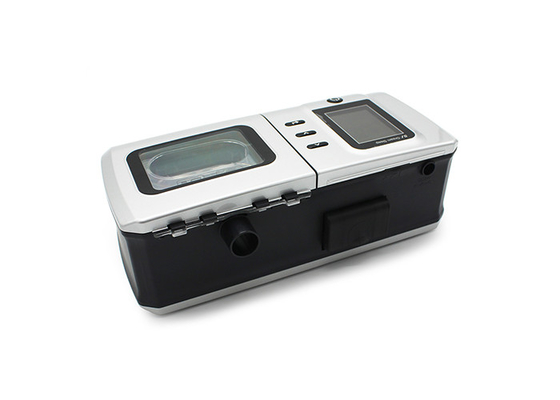 |
|
Sales & Support
Request A Quote -
Select Language
|
|
|
Health Medical Ventilator Automatic Cpap Machine Battery Operated Sleep Apnea Using
|
Product Details:
Payment & Shipping Terms:
|
| Screen: | 128*64 LCD | Colour: | Gray |
|---|---|---|---|
| Pressure: | 4-20cmH2O | EPR (1-3 Level): | 2-4cmH2O |
| Working DB: | ﹤30dBA (working At 10cmH2O) | Net Weight: | 1.8kg |
| Size: | 255*170*112mm | Ramp Duration: | 0-60mins |
| Function: | Treat Pulmonary Heart Disease | Product Name: | Health Medical Ventilator Sleep Apnea |
| Data Storage: | SD Card | DC Voltage: | 24VDC |
| DC Current: | 2.0A Maximum | ||
| Highlight: | automatic cpap machine,cap machine sleep apnea |
||
Health Medical Ventilator Automatic Cpap Machine Battery Operated Sleep Apnea Using
Product Feature
| 1 |
Auto-adjusting pressure for personalized treatment during sleep |
| 2 |
Auto-Altitude compensation:the pressure can be adjusted according to altitude to |
| 3 | Alarm for power off and mask off |
| 4 | Humidifier can heat without tank |
| 5 |
overheating protection: humidifier will auto-off when overheating |
| 6 | Real-Time display treatment data |
| 7 | 0-3 level EPR (expiratory pressure relief) |
| 8 | Alarm for power off or disconnected |
| 9 | 16GB SD card can save about 5years used records |
| 10 | Parameters lock: all the parameters cannot be changed after setting |
| 11 | Combined smart technologies |
| 12 | Contemporary and stylish design for bedroom appeal |
Product Description
Providing or increasing lung ventilation for patients using CPAP ventilators, portable ventilators with sophisticated components, stable and reliable airflow, barometric pressure measurement circuits, silent fans, user-friendly ventilation strategies and control circuits for analog circuit solenoid valves, and Various types of alarm measures and simple human-machine interface make the ventilator achieve strong reliability (safety), economy and comfort, and have simple handling characteristics. The ventilator can be used in the home environment or in medical institutions. No need for continuous professional monitoring
Ventilation method for home ventilator
1, intermittent positive pressure breathing: the most basic ventilation. When inhaling with a ventilator, a positive pressure is generated, the gas is forced into the lungs, and the body exhales the gas by itself.
2, exhalation platform: also called inspiratory positive pressure breathing, inhalation, before exhaling with the ventilator, the exhalation valve continues to close for a period of time, then open exhalation, this time generally does not exceed 5% of the respiratory cycle Can reduce VD/VT (dead cavity / tidal volume)
3, positive end-expiratory pressure ventilation: under the premise of intermittent positive pressure ventilation, use the ventilator to maintain a certain pressure in the end of the airway, play an important role in the treatment of respiratory distress syndrome, non-cardiogenic pulmonary edema, pulmonary hemorrhage .
Product Picture
![]()
Product Specification
| Product Name | Medical Cpap Machine |
| Screen | 128*64 LCD |
| Colour | Cray |
| EPR (1-3 level) | 4-20cmH2O |
| Working dB | ﹤30dBA (working at 10cmH2O) |
| Ramp Duration | 0-60mins |
| Net Weight | 1.8kg |
| Size | 255*170*112mm |
| Function | Treat Adult Obstructive Sleep Apnea |
| Accessories | The standard accessaries include a set of Nasal Mask, Head Belt, 6ft. Tubing, Filter, Power Cord, User's Manual and Carrying Case. |
Precautions During Use Of Home Ventilators
1.Intolerance:
When using the ventilator for the first time, the patient may feel uncomfortable. The nursing staff should give guidance, adjust the mask, adjust the parameters, and give psychological care. After the synchronization between the human and the machine, the patient's discomfort will be reduced or disappeared.
2.Oropharyngeal drying:
When using a ventilator, the patient may have dry mouth oropharynx. The mask should be adjusted to reduce air leakage and drink plenty of water. The use of a humidifying humidifier can effectively eliminate the above discomfort.
3.Facial crush:
In the stressed parts, such as: nose, , use a Q-shaped skin protective film.
Flatulence, discomfort:
Try to use the nose to breathe, talk less, and use drugs that promote gastric motility if necessary, such as: morphine.
4.Mouth leaks:
If a nasal mask is used, the mouth should be closed as much as possible when using the ventilator. Air leaks in the mouth can reduce the effect. If necessary, use a nose and mouth mask or use a chin strap to adjust the tightness of the mask in time.
5.Drainage obstacles:
When the patient has a sputum dysfunction, the family should regularly turn the patient over to pat the back, encourage more drinking water, guide the patient to have a cough and sputum sputum, and if necessary, inhale, if necessary, the family can give sputum
-
Portable Good Night Auto Cpap Machine Sleep Apnea Treatment With Humidifier
-
Home Use CPAP Breathing Machine With Automatic Altitude Adjustable Function
-
2.8 Inch Screen Non Invasive Auto Cpap Machine / Cpap Device For Treat Sleep Apnea
-
Traveling Bipap Auto Cpap Accessories Portable Medical Ventilator OLV - DS6
-
Automatic Altitude Compensation Mini Home Breathing Machine For Relieve Breathing Difficulties
-
Medical Auto Cpap Machine , Oxygen Concentrator Cpap Ventilator With Mask Off Alarm Function








